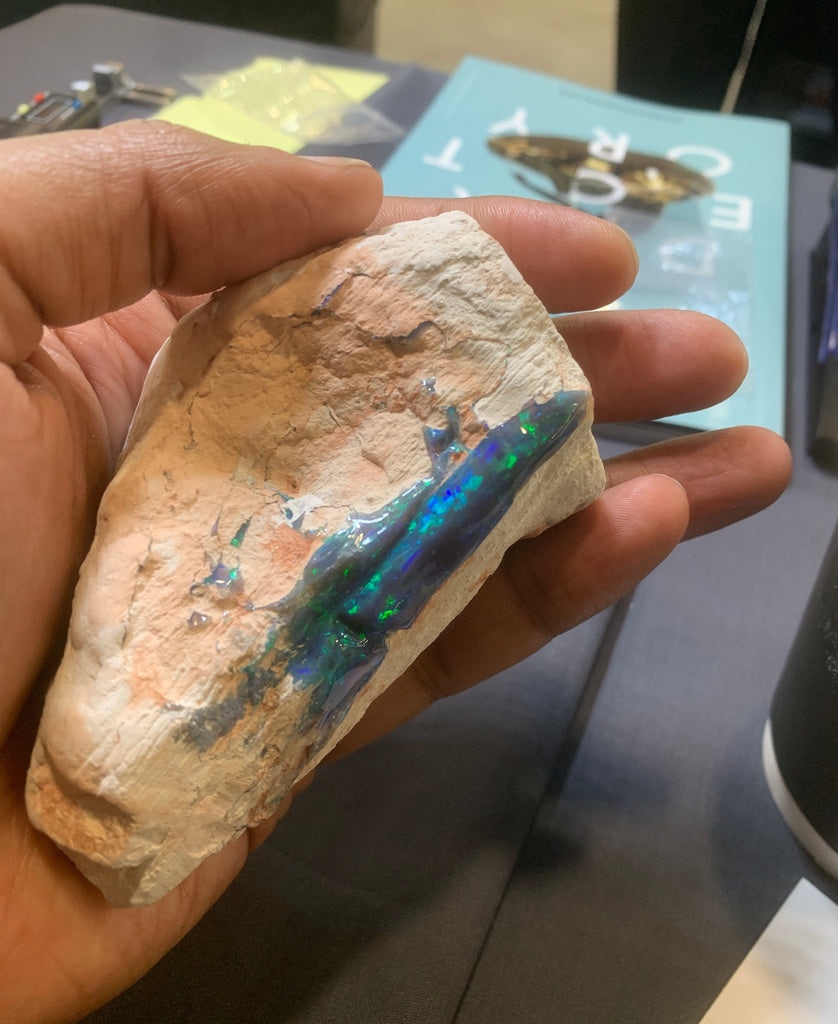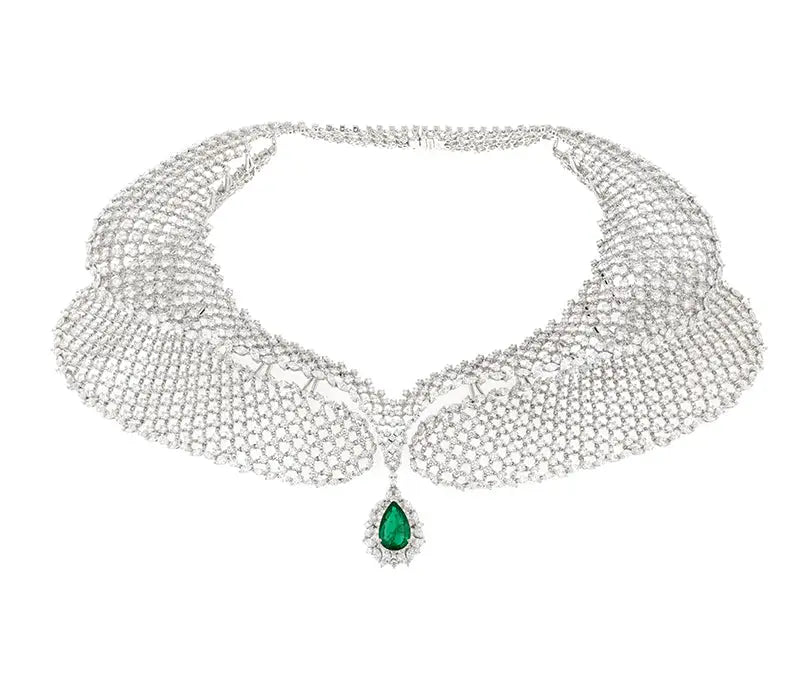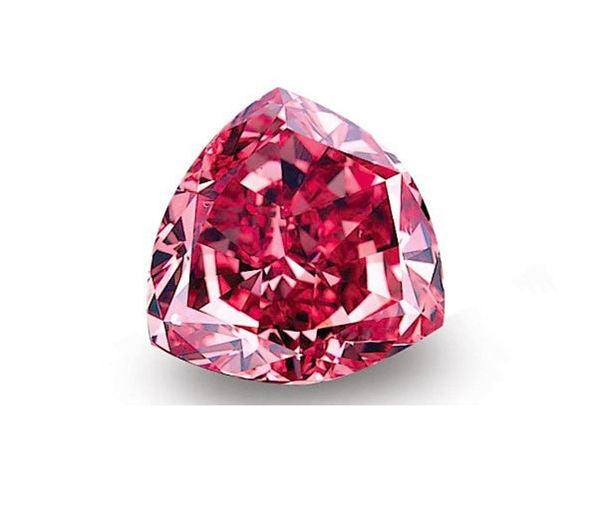
Rare Opalized Fossil Sees New Life in Extraordinary Sculpture
For Los Angeles-based gemstone dealer Anup Jogani, the pursuit of antique gems and jewels with exceptional provenance, history, and character is more than a passion—it's a way of life. His collection boasts rare treasures, from the prized rubies of Burma and the velvety blue sapphires of Kashmir to the vivid green emeralds of the Mughal Empire and the crystal-clear diamonds of India’s legendary Golconda Mine, all admired for their quality and distinct “personality.”
Among his collection, one gemstone stood out to him. It wasn't his most valuable acquisition, nor the only colored stone to ever captivate him, but it was something truly special: a rare black opal formed within petrified wood—a striking union of Mother Nature’s craftsmanship.
Jogani discovered this unique piece at a trade show in Miami, where it sat on the table of a fine-opals dealer. Intrigued, Jogani asked, “Is that for sale?” The dealer replied, “No, I haven’t the heart to cut the opal out of the petrified wood.”
Upon closer examination, Jogani was awestruck. “It was opalization and petrification coming together in one momentous geological soup!” he said, marveling at the fine opal and sublimely formed rock. The rarity of these two natural processes merging in one specimen ultimately compelled Jogani to make it his own.

Gem dealer Anup Jogani holds a rare piece of black opal formed in petrified wood. The extraordinary specimen inspired him to have a sculpture created that expands the piece on a much larger scale, with the hope that it would both educate and inspire.
To appreciate the significance of this piece, one must understand the geological process behind it. When a tree dies, microorganisms typically break down its organic matter. However, in rare instances, the tree becomes rapidly buried by mud, silt, or volcanic ash, which shields it from oxygen and thus slows the decay process. Over thousands of years, mineral-laden water or mud seeps into the tree’s structure, replacing its organic material with crystallizing minerals. In this case, the tree transformed into hydrated silica or opal (opalization) while maintaining the shape and structure of the original tree (petrification). It’s no wonder then that opal was once thought to have the power to preserve life!
Jogani was so enthralled by the story of its formation that he decided to share it with a broader audience. Since removing the opal would destroy the petrified wood, he chose to create a sculpture that would expand the original piece on a larger scale, to educate and inspire others.
“I was captured by the story,” Jogani said. “During the pandemic, I was reflecting on ways to merge the history of gems with the mythology of nature. Art plus nature equals a story.”

To bring his vision to life, Jogani enlisted three artisans, each a master in their field. Sculptor Chris Towle, known for his work on films such as Star Wars, Jurassic Park, and Avatar, was tasked with creating a petrified wood sculpture with faux opal seams that complemented Jogani’s original piece. Towle carefully considered the scale of the sculpture and how the faux opal seams would complement the original specimen. Then, using what he calls a “secret formula” process attained from decades of experience in his craft, Towle formed the main body of the piece using clay and silicone molds. His biggest challenge was replicating the opal’s color, luminosity, and iridescence, a painstaking process that took time to perfect.
“The faux seams of opal that I’ve embedded in the sculpture are [created from] an elaborate, time-consuming, multilayered system done by hand to achieve the luminous depth-of-color and iridescent qualities of reflected light,” Towle says. “I spent a lot of time fine-tuning the brilliance, color-depth and intensity. It was a long, protracted labor of love. The result is worth it.”

Next, artist Nathalie Tierce, Towle’s wife, an accomplished artist on projects as diverse as productions for Andrew Lloyd Webber, period dramas for the BBC, mural paintings for Disney, and feature films such as Tim Burton’s Alice, was given “the honor and slightly daunting last phase” of painting the sculpture, which “she enjoyed immensely.”
“The challenge of accurately mimicking the detail [of the original piece] was exciting,” says Tierce, whose lifelong inspirations as an artist, designer, and color consultant have been the colors and forms of nature. “To achieve the subtle variation of color, I used countless glazes of color, alternating between light and dark. I applied light washes with a fine, small brush. There were long waiting times between layers while the paint seeped into the sculpture’s surface, creating a natural, organic quality.”
Additional touches were put in the very capable hands of Kassandra Nicholson, a Graduate Gemologist, goldsmith, and fine jewelry designer, who perfected her craft as a bench jeweler for Fred Leighton in New York City, known for the exquisite vintage jewels it lends celebrities for red-carpet events, plus a signature collection.
Her contribution was to sculpt a gold accent for the original specimen to highlight its place in the sculpture, as well as a gold post for the sculpture to rest upon. She carved several options for the pieces in wax, and then with the team decided which would best complement the grain of the petrified wood.
The final pieces were created using a technique called the lost wax process, where Nicholson sculpted a block of hard jeweler’s wax into the desired shapes using carving tools and small files. The shapes were then cast into metal, cleaned, and polished.
“The project was different from my usual work of crafting jewelry,” Nicholson says. “It required shaping the wax to the irregular texture of the wood.”

A gold accent to highlight the original specimen’s place in the sculpture, as well as a gold post for the sculpture to rest upon, were crafted by Graduate Gemologist, goldsmith and jewelry designer Kassandra Nicholson.
Nicholson, who grew up in Alberta, Canada, spending time as a child on fossil hunts in the badlands of Drumheller and visiting museums of paleontology, says she was thrilled to be working with such a rare fossilized specimen containing opal, one of her favorite gems. To see the finished piece—which took eight months from the concept phase to integrating the faux opal seams and the original specimen, to painting—“makes her mind wander.”
“I imagine the journey a precious opal might go through, from rough to finished jewel,” Nicholson says. “I love how the contrasting elements come together. I’ve never seen anything quite like it.”
For Towle and Tierce—who were so struck by the beauty of the original piece that they were compelled to find the best way to honor and celebrate it—the final sculpture has surpassed their expectations, even giving Towle a hunger to explore other work like this and push it in new directions.
“I love how the marriage between a geological phenomenon and a sculpture has elevated them in a poetic union,” Tierce says.
For Jogani, the sculpture is “magnificent,” and like all of those involved in its making, he hopes it’s appreciated for its beauty and design. Just as importantly, Jogani hopes the sculpture sparks a curiosity in viewers about one of the extraordinary ways opals come into existence, leaves them in awe of what Mother Nature is capable of producing, and nourishes their souls the way it has each of its creators.


